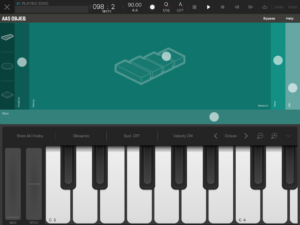We love Objeq Delay on the desktop; it’s perfect for otherworldly beatmaking and sound design. Now AAS brings a version of the effect to the iOS platform. Enter AAS Objeq – providing the same unique physical modeled resonator effects as its big brother, but this time without the delay.
AAS Objeq Features
- Three Physical-Modeled Resonators (Plate, Beam, Drumhead)
- Sonic Mangling of Beats recorded in a DAW or Live through the iPad/iPhone Mic
- AU Compatible Plugin
- Intuitive User Interface
- Full Control of Pitch, Tone, Decay, Position, and Mix
- Available at the iTunes App Store for $3.99
AAS Objeq offers iOS musicians the ability to add some sonic flavor to their beats. It easily fits right into your DAW’s effect chain – provided it supports the AU plugin format. Objeq gives you pro-level results at a nice price typical of an iOS music app.
An Easy Way to mangle your iOS Beats
The promo verbiage for Objeq focuses on using it to effect live beat creation, by playing with your hands on a surface near the iPad or iPhone mic. This is a similar manner as an older iOS app, Impaktor. I prefer to use Objeq as an effect in Beatmaker 3. It also works with any DAW compatible with the AU plugin format.

Objeq’s user interface is straightforward, especially if you are familiar with Objeq Delay, which we reviewed last year. Naturally, the iOS version sports simpler functionality, with an intuitive touchscreen friendly interface to match. Essentially you get to select the material for the resonator (Plate, Beam, or Drumhead), while controlling a variety of parameters for each, including pitch, tone, decay, position, and mix.
If you ever get confused, a help screen provides a quick overview of the functionality of each parameter. Objeq is really simple to use, so it warrants experimentation to discover which settings work best for your beatmaking or sound design scenario. Taps and finger slides are pretty much all you need to use the app.
Putting AAS Objeq to work in the iPad Studio
As mentioned earlier, the desktop Objeq Delay effect works great for beat mangling, so this approach made sense for the iOS version of Objeq. I fired up Bram Bos’s Ruismaker as a drum machine using Rozeta Rhythm the Euclidean drum sequencer from Bram’s highly regarded, Rozeta Sequencer Suite plugin collection reviewed here. Indeed, the beatmaking went well.
Copious coolness is achieved through the real-time tweaking of Objeq’s pitch parameter. This is the case with all three resonant materials. Dial-in the specific sound you need with the decay and position parameters. As noted earlier, experimentation definitely pays off.
While some of the additional functionality of the full desktop version of Objeq Delay is missed, Objeq’s support for the AU plugin format lessens that impact. For example, simply add a different delay app to the effects chain for a similar effect as the original.
The bottom line remains simple. If you want to take your iOS beatmaking to another level, AAS Objeq belongs on your music app shortlist. Its full range of physically modeled sonics definitely adds some life to iPad beats, sounds, and more. We give it our full recommendation.



